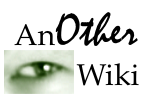Fae: Difference between revisions
m (added Category:Kintypes using HotCat) |
(→Otherkin Subculture: As on wikipedia, only talk pages should be signed, not articles.) |
||
| Line 37: | Line 37: | ||
== Otherkin Subculture == |
== Otherkin Subculture == |
||
Among the Otherkin subculture Fae is a type of otherkin and a general term for all types of creatures, including the list above. |
Among the Otherkin subculture Fae is a type of otherkin and a general term for all types of creatures, including the list above. |
||
== References == |
== References == |
||
Revision as of 13:57, 11 April 2012

In the English Language fey means otherwordly, able to see the future, or touched in the head. In popular culture the fey, if recognized at all, are small, winged, humanoid, female creatures who are frequently portrayed in the nude. [1]
Fae' can also be used as a collective term instead of describing one specific race. Classifications for fae include that of disposition, Seelie Court (Light) and Unseelie Court (Dark), and whether they live as a community (Troop) or on their own (Solitary). There are fey in every culture when the term is stretched to its broadest definition.[1]
Types of Fae
In mythology and folklore 'fae' encompasses many magical creatures including, but not limited to:
- Brownie
- Dryad
- Dwarf
- Elf
- Fairy
- Gnome
- Goblin
- Gremlin
- Hob
- Imp
- Kelpie
- Knocker
- Kobold
- Nixie
- Nymph
- Ogre
- Phooka
- Pixie
- Redcap
- Selkie
- Sidhe (pronounced "shee")
- Sprite
- Tomte
- Troll
- Trow
- Will'o'Wisp
- Xana
Otherkin Subculture
Among the Otherkin subculture Fae is a type of otherkin and a general term for all types of creatures, including the list above.
